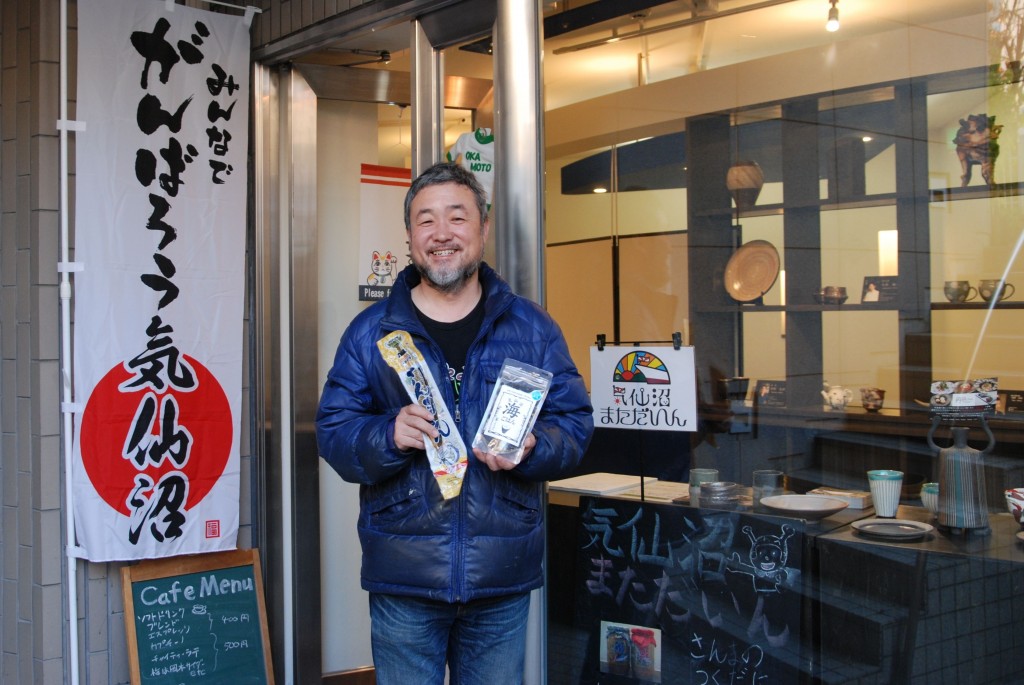
Located in Higashinada-ku, Kobe City, Okamoto Shopping Street exudes a sophisticated atmosphere. Having realized a successful recovery from the Great Hanshin-Awaji Earthquake, the shopping street is currently providing support for the recovery of Kesennuma, which was struck by the Great East Japan Earthquake, through the Kesennuma New Central Shopping Association. For example, the shopping street operates Kesennuma Matadain, a pilot shop opened as part of its efforts to support the recovery of Kesennuma. “Matadain” means “come back again” in the Kesennuma dialect. The key player in the recovery support activities is Mr. Akira Matsuda of the Okamoto Shopping Street Promotion Association.
 Supported by ties with others
Supported by ties with others
Mr. Matsuda experienced the Great Hanshin-Awaji Earthquake at his home in Okamoto when he was 34 years old. Fortunately, all his family survived the disaster, although his home completely collapsed. All his family except him evacuated from Okamoto to the countryside, while Mr. Matsuda himself continued to stay at a restaurant where he had been working in those days for about one month, until he moved to a new address.
Later, the restaurant where he was working went bankrupt. In 1999, Mr. Matsuda began to operate his own Italian restaurant, Aglioeolio.
After I opened my own restaurant, many customers from my previous restaurant came to visit my restaurant. I was supported not by the restaurant itself, but by the ties I had made with people there, such as the restaurant staff and customers.
 Photo:Aglioeolio, an Italian restaurant run by Mr. Matsuda, attracting many local regular customers
Getting to know one another directly—key to remembering the disaster
Photo:Aglioeolio, an Italian restaurant run by Mr. Matsuda, attracting many local regular customers
Getting to know one another directly—key to remembering the disaster
In March 2011, the Great East Japan Earthquake struck.
As the situation of the affected areas began to be revealed, the momentum to provide support for such areas grew throughout Okamoto. We felt that we must do everything we could. Behind that feeling was a sense that we wanted to reciprocate the support that we ourselves had received before.
A circle of support was first formed mainly among Mr. Matsuda’s frequent associates, and then expanded through Facebook and other tools, drawing many people who shared the same idea.
Mr. Matsuda already knew through his own experience that people receive great power through ties with other people. He wanted to provide support for a specific area, rather than the affected areas in general, and to get to know those who would receive support from him and his companions directly. Accordingly, Hyogo Prefecture introduced him to Miyagi Prefecture’s Commerce and Industry Bureau, which introduced him to the Kesennuma Chamber of Commerce and Industry, which in turn introduced him to Kesennuma New Central Shopping Association.
In June 2011, he and his companions rented a bus and visited Kesennuma for the first time, in order to identify what was actually needed in the affected city. On the second visit that they made in October of the same year, they spread survivor information on behalf of the local residents, provided moral support by exchanging letters, and interacted with business proprietors. They still continue to visit Kesennuma three or four times a year, and provide much needed support each time.
If we merely send donation money, we will soon forget about the disaster. But if we get to know those who are receiving our support directly, we can remember that we must do something for specific people whom we have met on specific occasions. To ensure that this works, I believed that some kind of symbol or framework for continuing our efforts is necessary.
 Photo: Providing IT support. At first, Mr. Matsuda and his companions spread survivor information on behalf of the local residents. With the passage of time, their efforts have been diversified to include holding cosmetics/make-up volunteer events and women’s meetings.
Photo: Providing IT support. At first, Mr. Matsuda and his companions spread survivor information on behalf of the local residents. With the passage of time, their efforts have been diversified to include holding cosmetics/make-up volunteer events and women’s meetings.
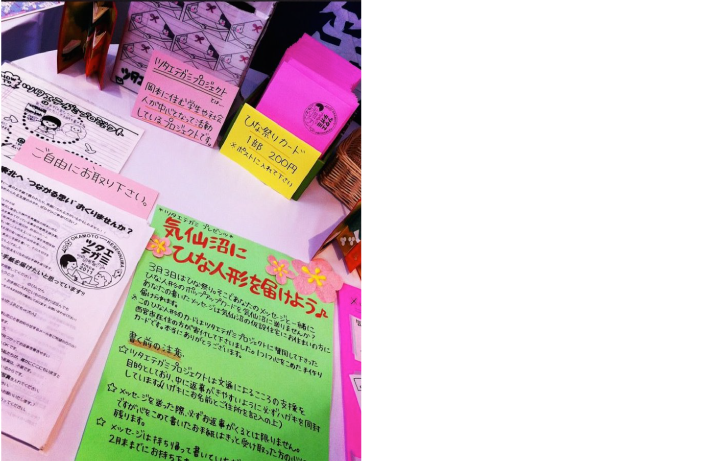 Photo:Tsutaetegami (communication through letters) project conducted by university students, aiming at interaction through letters
Seeing an area you have no links to as someone’s hometown
Photo:Tsutaetegami (communication through letters) project conducted by university students, aiming at interaction through letters
Seeing an area you have no links to as someone’s hometown
By frequently visiting Kesennuma, Mr. Matsuda came to realize the excellence of various Kesennuma specialties, such as saury and thick wakame leaves. He also believed that to help vitalize the entire community, it would be necessary for business proprietors to become energized.
In this regard, he and his companions decided to establish a framework for continuing support for the recovery of Kesennuma through shopping. They opened a pilot shop carrying specialties from Kesennuma in an unoccupied space in Okamoto Shopping Street. In February 2012, the shop, named Kesennuma Matadain, was opened, using a subsidy from the Tohoku Bureau of Economy, Trade and Industry. The first plan was to run the shop for only about two months. Thanks to the shop’s good reviews from customers and favorable sales, however, it was expected that it would be possible to continue the shop without a subsidy. Since April 2012, the shop has been operated on a permanent basis.
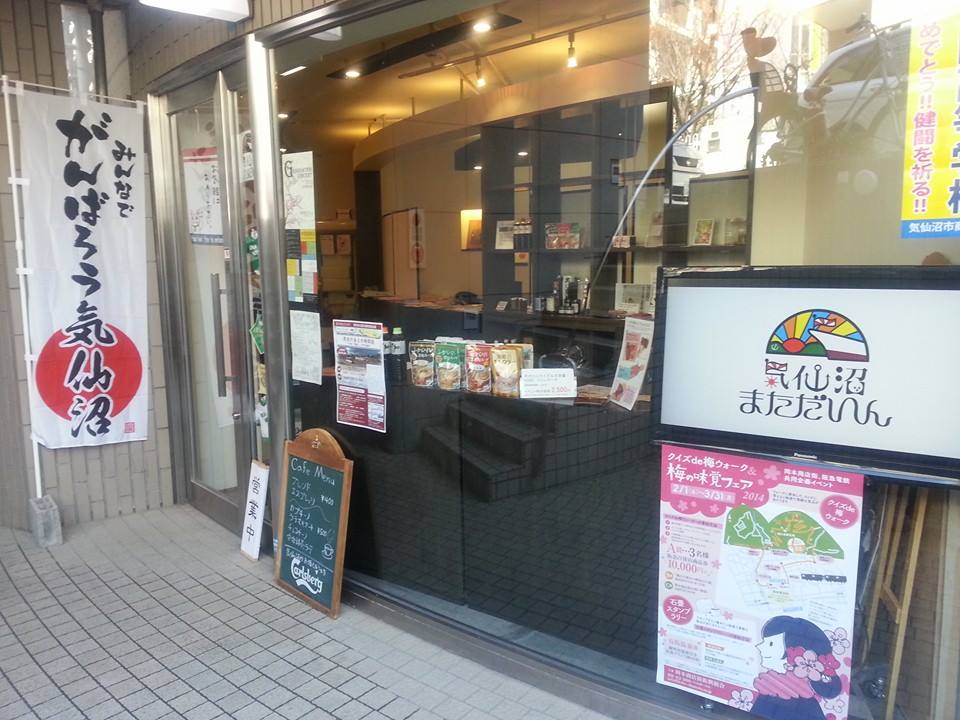 Photo:Kesennuma Matadain
Photo:Kesennuma Matadain
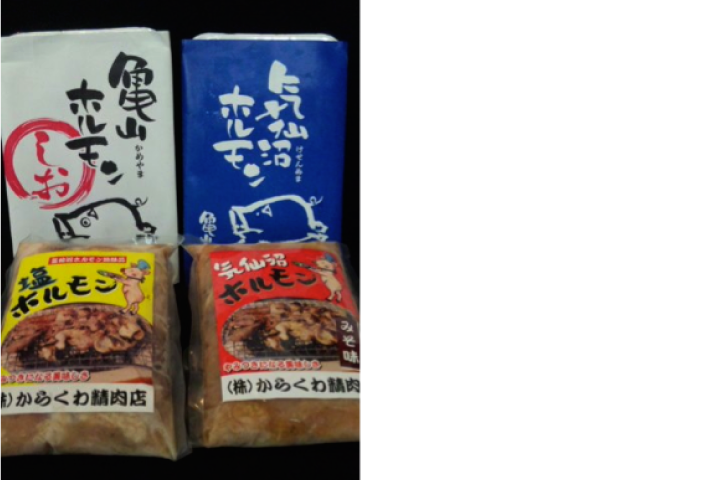 Photo:Kesennuma horumon (offal). It is said that this widely popular dish originated as a food that deep-sea fishermen loved to eat, especially when returning to port.
Photo:Kesennuma horumon (offal). It is said that this widely popular dish originated as a food that deep-sea fishermen loved to eat, especially when returning to port.
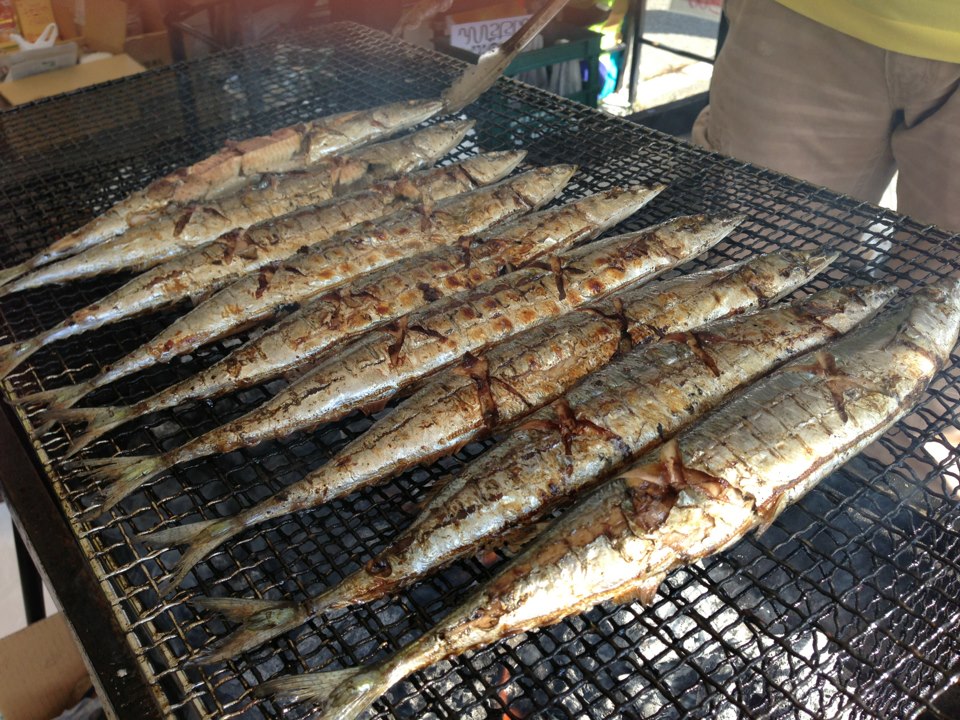 Photo:At some events, saury is grilled and sold.
Photo:At some events, saury is grilled and sold.
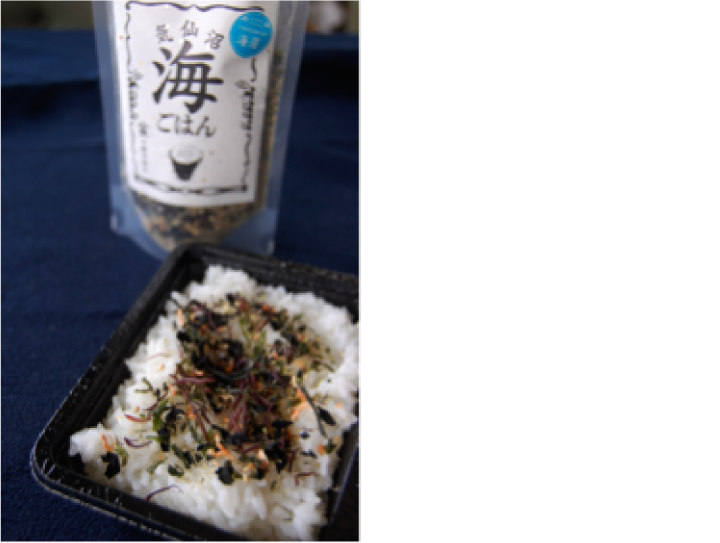 Photo:Umi-gohan, a seafood rice seasoning, a newly developed product. The shop’s staff are actively working on product development, using ingredients from Kesennuma.
Photo:Umi-gohan, a seafood rice seasoning, a newly developed product. The shop’s staff are actively working on product development, using ingredients from Kesennuma.
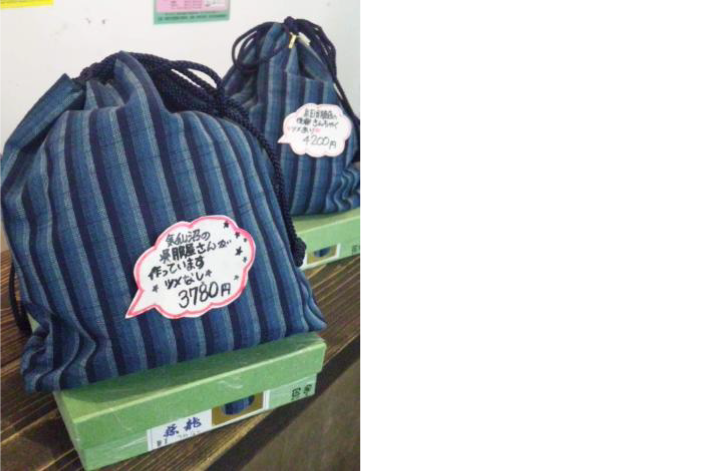 Photo:Bags made by a kimono fabric shop in Kesennuma. Such bags make great gifts.
Photo:Bags made by a kimono fabric shop in Kesennuma. Such bags make great gifts.
Staff members from Kesennuma are stationed at Kesennuma Matadain. While serving customers, such staff members refer to Kesennuma in passing. Hence, the customers begin to regard Kesennuma, a place they had no links to before talking with the staff members, as the hometown of the staff members.
Mr. Matsuda also says that when participating in Kobe Luminarie, the Kobe Marathon, and other events, people who who would like to do something for the Tohoku region often talk to staff members of Kesennuma Matadain.
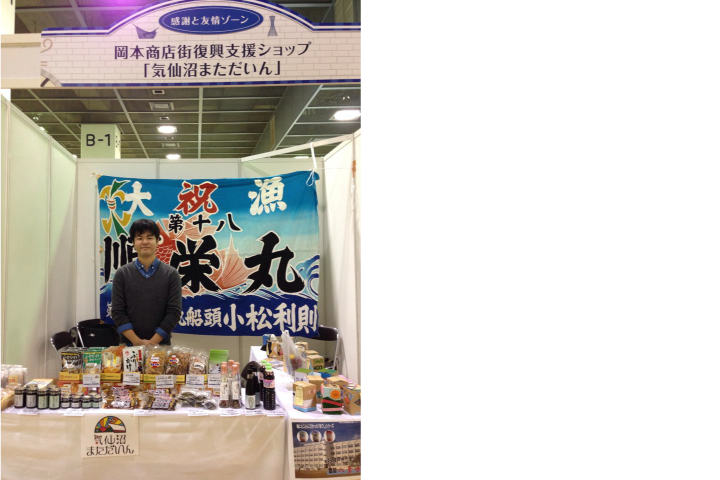 Photo: Kesennuma Matadain’s booth at the 2014 Kobe Marathon EXPO, which provided an opportunity for the organization to launch a new activity
Photo: Kesennuma Matadain’s booth at the 2014 Kobe Marathon EXPO, which provided an opportunity for the organization to launch a new activity
Kesennuma Matadain cooperates with the local Motoyama Junior High School’s career development program, accepting a number of students. Moreover, the organization once took students from the junior high school to Kesennuma by bus.
In June 2012, the organization was registered in Kesennuma as Matadain Co., Ltd. The aim of this registration was to support the city’s recovery, even if only in a small way, by paying corporation tax to Kesennuma.
Seeing the current situation of Kesennuma, I feel that there is still a long way to go to achieve the city’s recovery. Many people in the Tohoku region are modest, but if they just wait for the government to do something for them, I imagine it’ll be difficult for them to recover. I hope that through the experiences that we have accumulated in Okamoto Shopping Street in the process of our recovery, we can help people in the Tohoku region seek action from the government.
The secret of Okamoto Shopping Street, which is even more vibrant than before the disaster
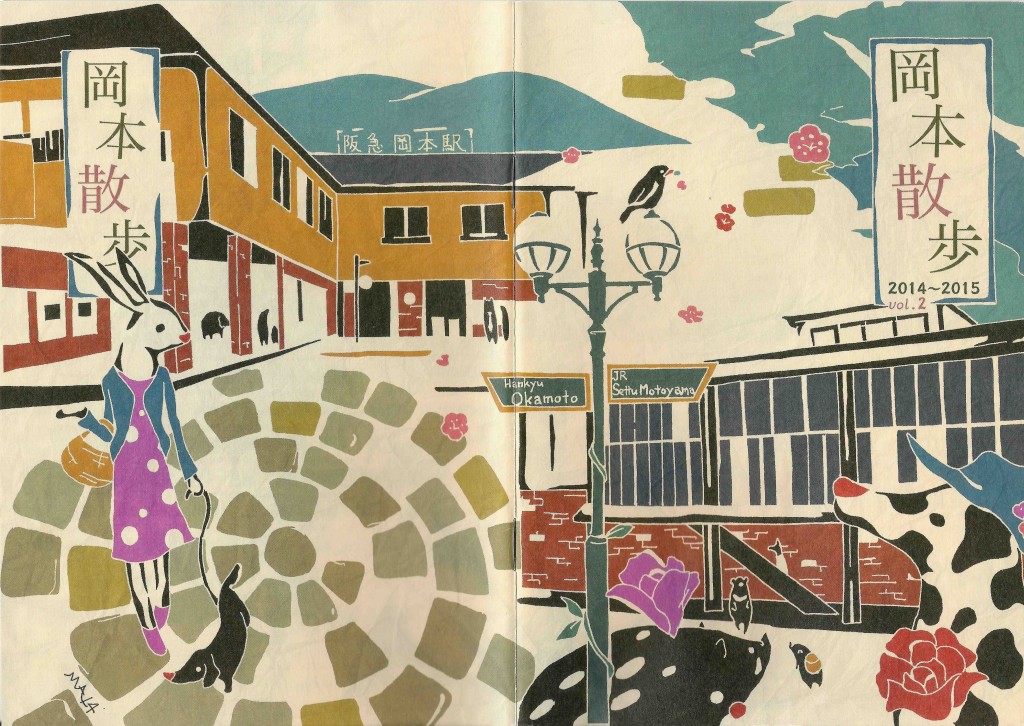 Photo:Okamoto Sampo (Okamoto Strolling Map), issued by the Okamoto Shopping Street Promotion Association. The booklet carries interviews, shop information, and many other contents.
Photo:Okamoto Sampo (Okamoto Strolling Map), issued by the Okamoto Shopping Street Promotion Association. The booklet carries interviews, shop information, and many other contents.
According to Mr. Matsuda, Okamoto Shopping Street has begun to attract many more people than it did prior to the Great Hanshin-Awaji Earthquake. This is partly thanks to its good location and the sophisticated atmosphere created by its stone pavements. However, it seems that the key lies in Okamoto’s own approach to community development.
In terms of community planning, the government tends to establish specific zones, such as commercial districts and residential districts. Actually, some communities have been developed that way in the process of reconstruction from the disaster. However, if a newly developed community is very different from how it used to be, I feel that the residents will find the community uncomfortable to live in.
Mr. Matsuda often refers to the city theory of Jane Jacobs, a journalist and the author of The Death and Life of Great American Cities and other books. Jacobs insists that diversity is essential for creating a safe, livable city with sufficient economic vigor, and indicates the following elements as the four generators of diversity:
(1) The need for mixed primary uses
(2) The need for short blocks
(3) The need for old buildings
(4) The need for density
First, the “need for mixed primary uses” means the need for multiple uses, such as shops and homes. In Okamoto Shopping Street, shops and homes are co-located, creating diversity. In addition, if there are homes in a community, it follows that the community’s security is protected even at night, thanks to the people living in those homes.
Second, the “need for short blocks” means that there should be many short blocks. Okamoto Shopping Street has eight blocks in the area located between Hankyu Okamoto Station and JR Settsu-Motoyama Station. The area’s web of alleys allow you to try a wide variety of routes to get to your destination, adding a sense of adventure to your stroll.
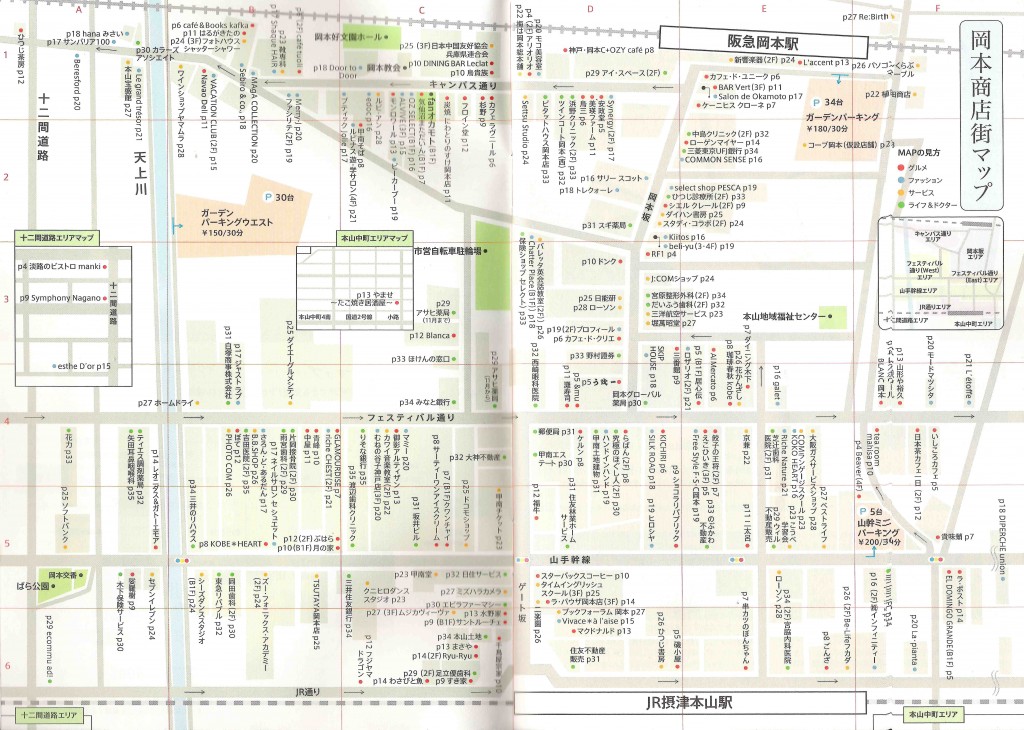 Photo:If you actually stroll through Okamoto Shopping Street, you will realize how tangled the narrow alleys are.
Photo:If you actually stroll through Okamoto Shopping Street, you will realize how tangled the narrow alleys are.
Third, the “need for old buildings” means that old buildings with low rents are necessary to ensure there are a wide variety of shops in a community. In Okamoto Shopping Street, where the percentage of building owners to total shop operators is low, rents are a critical element for continuing to run shops for a long period of time.
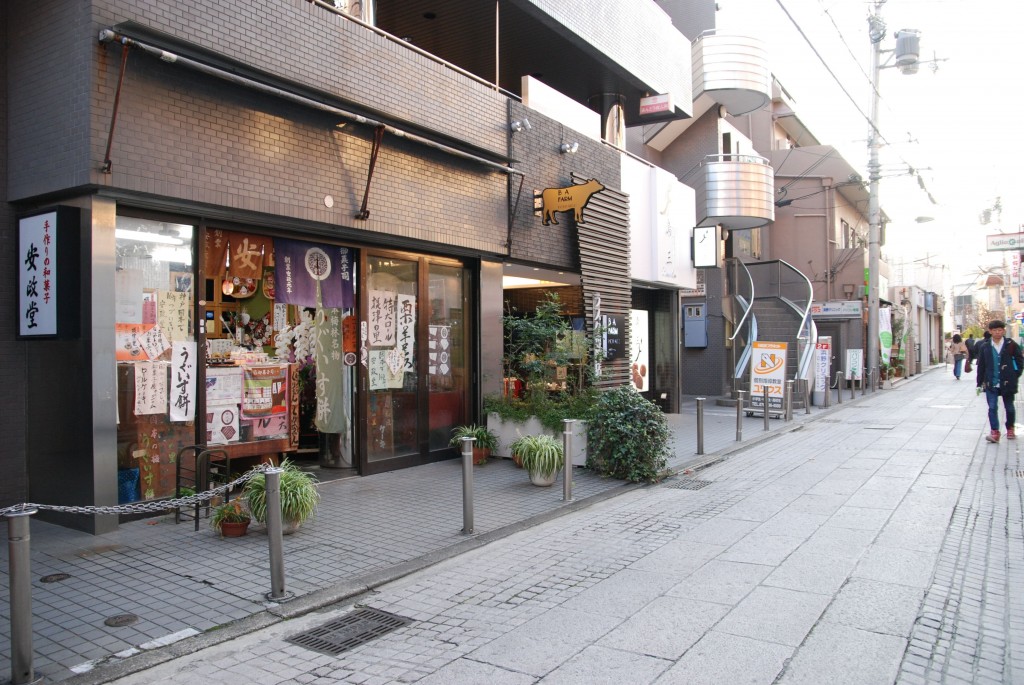 Photo: While some shops are long established with a history of more than 100 years, others have been opened recently.
Photo: While some shops are long established with a history of more than 100 years, others have been opened recently.
Fourth, the “need for density” means that a certain level of population density is necessary. The population of Okamoto has become larger than it was before the occurrence of the Great Hanshin-Awaji Earthquake. This is mainly because Hankyu’s limited express trains have begun to stop at Okamoto Station, and because apartment buildings have been constructed on properties where there used to be collapsed buildings due to the earthquake.
This community development model will surely serve as a significant example for shopping streets that are aiming at recovery from the Great East Japan Earthquake.
A community that children will return to after coming of age
Mr. Matsuda has learned the importance of ties with people through his own experience of the Great Hanshin-Awaji Earthquake. Using the lessons he has learned by engaging in the recovery of his community, he is currently providing support for the recovery of Kesennuma, with a focus not only on the city’s immediate profit, but on the city’s future.
The city’s recovery needs to be realized in a way that will make children want to return there after coming of age.
If adults respect the power that can be generated through ties with people, children will surely learn a lot from such an attitude. If adults continue to take steps forward with hopes for the future in mind, children who leave their hometowns will find them attractive places to return to someday.
What makes Okamoto Shopping Street special is not only its sophisticated atmosphere and stone pavements. If you visit the shopping street, you will be unexpectedly hit by a pleasant sensation akin to nostalgia, and will feel like visiting there again. This is probably because you might have already become part of the network of ties with people in Okamoto Shopping Street without even knowing it.
(Interviewed and written by Fumie Matsuyama)
This article was created with the cooperation of
greenz.jp.
![]() an owner-chef
an owner-chef JP | EN
JP | EN JP | EN
JP | EN

 Photo:Aglioeolio, an Italian restaurant run by Mr. Matsuda, attracting many local regular customers
Photo:Aglioeolio, an Italian restaurant run by Mr. Matsuda, attracting many local regular customers Photo: Providing IT support. At first, Mr. Matsuda and his companions spread survivor information on behalf of the local residents. With the passage of time, their efforts have been diversified to include holding cosmetics/make-up volunteer events and women’s meetings.
Photo: Providing IT support. At first, Mr. Matsuda and his companions spread survivor information on behalf of the local residents. With the passage of time, their efforts have been diversified to include holding cosmetics/make-up volunteer events and women’s meetings. Photo:Tsutaetegami (communication through letters) project conducted by university students, aiming at interaction through letters
Photo:Tsutaetegami (communication through letters) project conducted by university students, aiming at interaction through letters Photo:Kesennuma Matadain
Photo:Kesennuma Matadain Photo:Kesennuma horumon (offal). It is said that this widely popular dish originated as a food that deep-sea fishermen loved to eat, especially when returning to port.
Photo:Kesennuma horumon (offal). It is said that this widely popular dish originated as a food that deep-sea fishermen loved to eat, especially when returning to port. Photo:At some events, saury is grilled and sold.
Photo:At some events, saury is grilled and sold. Photo:Umi-gohan, a seafood rice seasoning, a newly developed product. The shop’s staff are actively working on product development, using ingredients from Kesennuma.
Photo:Umi-gohan, a seafood rice seasoning, a newly developed product. The shop’s staff are actively working on product development, using ingredients from Kesennuma. Photo:Bags made by a kimono fabric shop in Kesennuma. Such bags make great gifts.
Photo:Bags made by a kimono fabric shop in Kesennuma. Such bags make great gifts. Photo: Kesennuma Matadain’s booth at the 2014 Kobe Marathon EXPO, which provided an opportunity for the organization to launch a new activity
Photo: Kesennuma Matadain’s booth at the 2014 Kobe Marathon EXPO, which provided an opportunity for the organization to launch a new activity  Photo:Okamoto Sampo (Okamoto Strolling Map), issued by the Okamoto Shopping Street Promotion Association. The booklet carries interviews, shop information, and many other contents.
Photo:Okamoto Sampo (Okamoto Strolling Map), issued by the Okamoto Shopping Street Promotion Association. The booklet carries interviews, shop information, and many other contents. Photo:If you actually stroll through Okamoto Shopping Street, you will realize how tangled the narrow alleys are.
Photo:If you actually stroll through Okamoto Shopping Street, you will realize how tangled the narrow alleys are. Photo: While some shops are long established with a history of more than 100 years, others have been opened recently.
Photo: While some shops are long established with a history of more than 100 years, others have been opened recently.